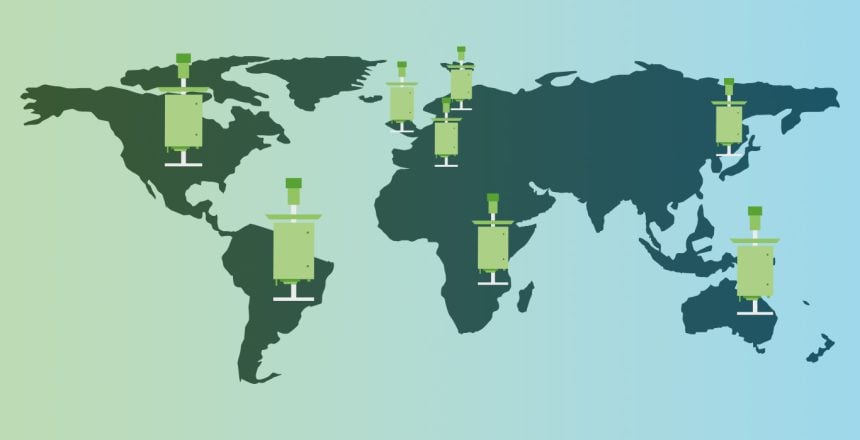To address this question, in this article we look at our systems for real-time monitoring of pollen. We show which pollen types SwisensPoleno can currently identify. You will also learn what options are available if the pollen taxa you are looking for is not on the list.
Before we get down to the substance, here is a short explanation of how SwisensPoleno distinguishes the different particles and pollen types from each other.
Identifying pollen with supervised machine learning
SwisensPoleno Mars measures each individual particle and collects the morphological properties. The system does this by capturing two holographic images of each measured particle in flight. These images show the characteristic shapes and sizes of the pollen, which the artificial intelligence of SwisensPoleno Mars uses for recognition. We humans do the same quite well, although the holographic images of the pollen look different from when we look at it under the microscope.
SwisensPoleno Jupiter, on the other hand, contains additional measurement methods and can measure further properties of a particle. In practice, however, it has been shown that the AI can distinguish many pollen types very well on the basis of the holographic images. In this sense, we can say that SwisensPoleno Mars is sufficient for real-time pollen monitoring in most cases. In this article, we will from now on only refer to pollen detection with SwisensPoleno Mars.
Learn more about the differences between SwisensPoleno Mars and Jupiter in the following article
What should I understand by artificial intelligence?
Speaking of artificial intelligence, we specifically mean “supervised machine learning”. Here is a brief explanation of its basic principle.
“Supervised machine learning is a process of machine learning where a data set with a known target variable is presented to an algorithm. The algorithm learns the correlations and dependencies in the data that explain these target variables. After training, the prediction produced by the algorithm is evaluated for its quality. Subsequently, the learned patterns are applied to unknown data to produce predictions (Datasolut, 2022).”
In our case, SwisensPoleno Mars should be able to distinguish between the different pollen types. To do this, we train the algorithm with a data set that consists exclusively of particles of a certain pollen type (e.g. birch or Betula pendula). We then speak of a training data set. We create this training data set by collecting fresh birch pollen and then measuring it with the system. For this purpose, the pollen is atomised at the inlet of the SwisensPoleno Mars with the help of the SwisensAtomizer while the system is running and measuring. Thanks to this training data set, the algorithm learns to recognise or correctly identify Betula pendula. We carry out exactly the same procedure with other pollen types. At the end of the training, the artificial intelligence of SwisensPoleno Mars is ready to automatically recognise and monitor the trained pollen varieties in real time.
Which pollen can SwisensPoleno Mars currently monitor?
Currently, our list includes 14 different pollen types, as listed in the table below. The focus is on pollen that are relevant for people with pollen allergies in Central Europe.
| Nr. | Taxa lat. | Nr. | Taxa lat. | Nr. | Taxa lat. | Nr. | Spezial |
| 1 | alnus | 6 | fagus | 11 | populus | 15 | Wasser |
| 2 | betula | 7 | fraxinus | 12 | quercus | ||
| 3 | carpinus | 8 | pinaceae | 13 | taxus | ||
| 4 | corylus | 9 | platanus | 14 | ulmus | ||
| 5 | cupressus | 10 | poaceae |
The algorithms for these 14 pollen varieties are validated and run on all our systems in Central Europe. This is the case, for example, in Switzerland, Germany, France, Finland, Lithuania, Spain and the UK. As shown in the table, there is another class for water droplets (number 15). Here we briefly explain why.
Can SwisensPoleno identify water drops as well as pollen?
It is true that SwisensPoleno Mars easily measures and detects raindrops and shows on which days it has rained. However, the actual reason for the “water” class is different. In the past, the algorithms misclassified raindrops as grass pollen. In the illustration below, you can see an example of a grass pollen grain and an example of a water droplet. The similarity of size and shape in the holographic images is immediately apparent. The algorithm can now easily distinguish between them thanks to the additional particle class “water”. But now back to the pollen.
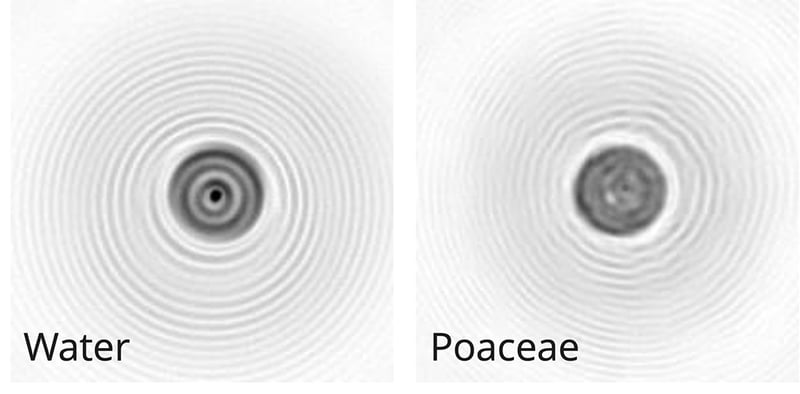
Why do the algorithms only work for Central Europe?
The main reason is that in other regions of our earth there are other plants and pollen that cause allergies. These are missing in the algorithm for Central Europe. Therefore, the algorithm has to be adapted.
Aren’t the same pollens exactly the same elsewhere?
This question cannot be answered at present because it has not yet been conclusively investigated. There have been observations that, depending on the country or region, the same pollen varieties vary slightly in size, for example. In this respect, this can lead to these pollens being classified less well or even incorrectly. For example, grass pollen (Poaceae) consists of a plant family of about 780 genera and 12000 species, which are morphologically very similar, but form a different mix in each country.
To ensure the quality of the real-time data, it is worth adapting the algorithms to the local flora. In concrete terms, this means generating data sets of local pollen and training the algorithms with them. We typically recommend this procedure during the first pollen season with the new real-time measurement system and thus move on to the next section.
How can SwisensPoleno Mars be trained on the local flora?
SwisensPoleno Mars can be trained to identify additional particles and pollen types. For this purpose, we have developed a process (see figure below).
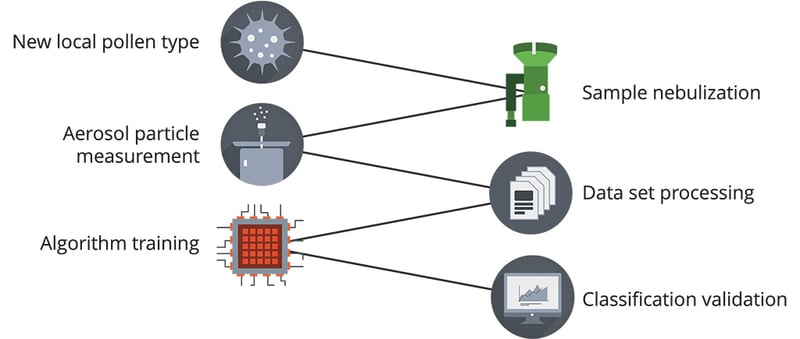
The extension process lasts for one pollen season and has to be done once. Ideally, one starts with the start of the new pollen season and collects fresh pollen of a pollen variety that the system is to identify. An amount of 0.3ml (or about 0.1g) is quite sufficient. To generate the training data set, the measuring system has to suck the particles out of the air. To do this, an aerosol must be created – a mixture of suspended particles in a gas. With the help of the SwisensAtomizer, the pollen is atomised from a macro-volume cuvette into the air in a controlled manner and then aspirated by SwisensPoleno Mars.
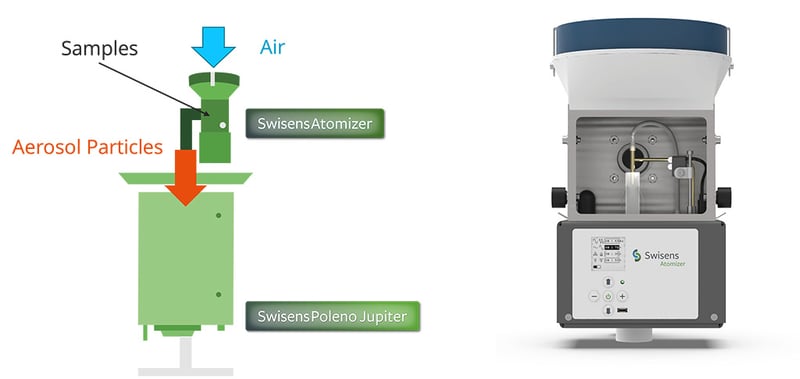
Because the collected pollen is typically not pure, sometimes two pollen grains stick together or the air contains foreign particles, the measured data must be cleaned afterwards. This can be done easily and quickly with Swisens software tools such as SwisensDataExplorer. This tool is supplied with the instrument. In the next step, the measurement data is divided into two data sets (training data set and verification data set) and used for training.
The cleaner the training data set, the better the training and the identification algorithm will work. This process must be carried out for each type of pollen that the system should be able to recognise.
The SwisensPoleno Mars uses only the holographic images for recognition. Although all systems are built exactly the same and continuously recalibrate themselves, the individual components are subject to certain tolerances that can lead to minimal differences in the images. Therefore, generalisation can be further increased by generating training data with two systems.
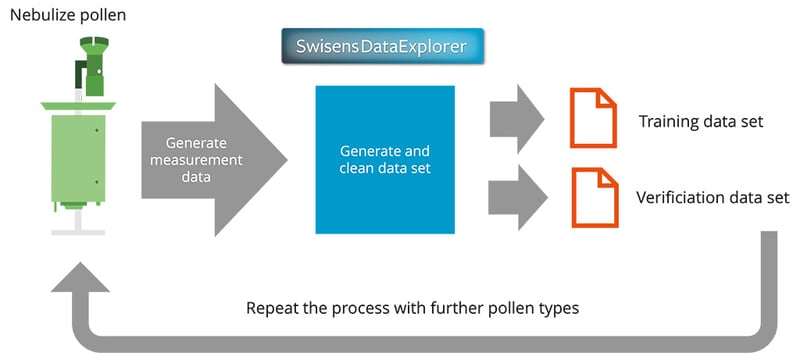
We use the obtained training datasets for the machine learning process to train the new identification algorithm. For qualification, the trained algorithm must recognise pollen types from an unknown dataset. The verification dataset is used for this purpose. The result is a so-called confusion matrix. This provides information about the accuracy of the new algorithm.
How can you check the quality of a new algorithm?
For the validation of a new algorithm, a Hirst pollen trap should be operated in parallel as well as in the immediate area for one season in addition to a SwisensPoleno Mars as a reference.The measurement data recorded by SwisensPoleno Mars throughout the pollen season is reclassified with the new algorithm at the end of the season. The result is a time series with the concentrations of the different pollen types. The time resolution is chosen to be the same as that of the reference data of the Hirst pollen trap. Typically, this is a daily resolution. The time series from SwisensPoleno Mars and the Hirst pollen trap are then compared and the correlation determined.
Does each SwisensPoleno need its own algorithm?
No – the entire procedure only needs to be carried out once on one (or two) SwisensPoleno Mars. The algorithms trained with it can be transferred to the other systems in the network. Swisens offers expertise to adapt the algorithms to the local flora by means of the described procedure and to support the customers in the process.
What is the final result after the first pollen season with SwisensPoleno Mars?
At the end of the first pollen season, local pollen algorithms are available. From then on, SwisensPoleno Mars automatically monitors and identifies pollen in real time. Once the measurement data is stored, it can be reclassified with a new algorithm as often as desired. A reclassification with a new algorithm based on the raw measurement data is possible at any time for the data from a single measurement station as well as for the entire network.
Is there another benefit of reclassification?
It may happen that during the first pollen season, training data cannot yet be generated from all relevant pollen types. As soon as the missing training data have been recorded in the following pollen season, a new identification algorithm can be generated and the existing measurement data from the previous season can be reclassified. A validation with the reference data of the previous season over all relevant pollen varieties is thus possible without further delay. At this point we come again to the first initiated question:
Can SwisensPoleno now identify the pollen in my region?
We say YES!
Our development department works daily on the further development of new algorithms. In addition, we maintain a constantly growing particle database with data sets for trainings. So it may be that regionally adapted algorithms already exist for your country. Contact us if you would like to know more. We will be happy to help and support you wherever we can.
Patrick Minder
Marketing & Sales

